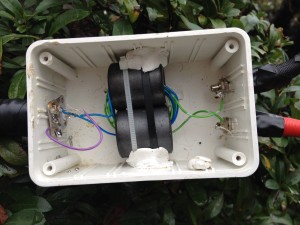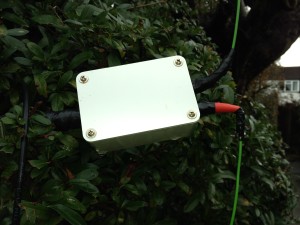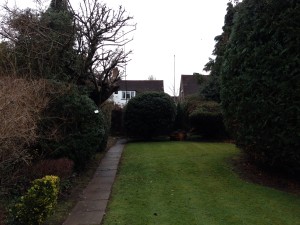I recently revamped my Flag antenna which has served me so well for MF dxing in this very suburban London location. It was around 8m by 3m but I made the vertical sections longer and the horizontal section slightly longer as well so it is now 9m x 4m.
The major change was that I constructed a balun. I had been using a balun made for the Flag antenna by eBay seller kafa2500 which was well made, waterproof and reasonably priced – however i thought I would have a go myself. In the end I ended up making two baluns which i’ll describe and show here.
Remember the purpose of the balun is two fold – primarily to transfer the wave energy of the desired signal from the antenna to the feeder cable – RG58 in my case. The second purpose is to prevent common-mode currents flowing along the balun which could cause RF problems in the shack. The latter is not an important consideration for the receive only paradigm. The balun will not help with directivity or nulling. The energy is transferred by the balun using magnetic induction which is a manifestation of the Work form of energy transfer – http://en.wikipedia.org/wiki/Energy_transfer
The first balun was constructed using a pair of largish monocular toroids picked up a the Kempton ham rally, bound together in a box picked up for £1 at the same rally. The windings ratio is 11:3 using 24 swg magnet wire from Maplins. I was intending for 12:3 following advice from N2VV but could not get the 12th turn through! Believe me it’s not critical. The SO239 and phono antenna sockets I had in stock. Here’s a close-up picture of the beast:
and here is how it looks with the box top screwed down- all connections are wrapped with self-amalgamating tape with black electrical tape on top and liberally smeared with vasoline to further combat water ingress, especially the box top screw holes.
For context a picture of the garden showing part of the Flag antenna wires and balun box:
This new Flag antenna works very well with excellent signal/noise characteristics from LF up to 26 Mhz and beyond. It also delivers a decent signal strength hence not necessitating the use of a pre-amp.
I also made a similar balun with an Amidon binocular toroid BN-73-202 kindly sent to me by N2VV. The BN-73-202 is very highly thought of by serious low band dxers. I aimed for the same turn ratio but think I ended up with 10:3 – again it works very well but for the moment I am long-term testing the larger toroid model. Here’s a picture:
I think the reason people complain about low signal strengths from Flags and lack of coverage above 4-6 MHz is purely down to the choice of toroid and the turns ratio used. You can’t just use any old toroid and a random turns ratio – source a proper high quality toroid and use an appropriate turns ratio.




